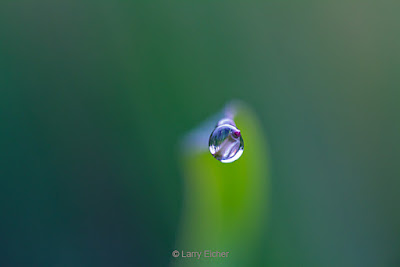 |
| Water Droplet (water_drop_ms_vv1623_20) |
I'm cleaning out my workshop in the basement in an on going fashion. I came across this one framed in a lovely "glitzy" frame.
 |
| Framed (water_drop_ms_vv1623_20) |
I find myself struggling to understand, "What is wrong with this work?" It couldn't have been the price. I asked just $46.80 for it. I was and still am in love with it. When I look at it I see a spot in the off center lower left. I see a light green simple curve moving backward into the the image and I see a background with a fade right to left of a bluish green color. I see turquoise in there.
I finally come back to the spot and look closer. I see an image in it. The landscape is upside down in it. I see the sky and the grass. I had to use my loop to see the diagonal portion of it. It was shot on 7-18-11 at Gorman Nature Center.
It is worth at least a third look and maybe more. What is wrong with that? Are pictures on the wall to catch our interest and more importantly our minds?
 |
| water_droplet_ms_vv1624_03 |
This one was shot two days later and has a Field of View of 7.25mm. It is 3.08x on the sensor. I like this one better cause the droplet shows the blue sky and greeen grass. I shows also the sun too. I like the top one better because of the pleasing overall color.
They demand that we as viewers remember some history: "
Your homemade microscope is much like the first magnifying devices two Dutch inventors created.
Zacharias Janssen made some of the first eyeglasses in the 1500’s and is credited with inventing the first compound microscope around 1590. Anton van Leeuwenhoek later created microscopes in the 1600’s that could magnify objects more than 270 times." (from Boys Life Magazine) Again the image is upside down in the drop just as it is in a camera lens shining an image on the sensor.
Thanks to www.visioneng.com for this look at ancient microscopes.
The water droplet above could have been available to man maybe 2000 years ago. All that was needed was an open wondering mind, observation and experimentation.
Your homemade microscope is much like the first magnifying devices two Dutch inventors created.
Zacharias Janssen made some of the first eyeglasses in the 1500’s and is credited with inventing the first compound microscope around 1590. Anton van Leeuwenhoek later created microscopes in the 1600’s that could magnify objects more than 270 times." (from Boys Life Magazine) Again the image is upside down in the drop just as it is in a camera lens shining an image on the sensor.
 |
| Ancient-Microscopes |
The water droplet above could have been available to man maybe 2000 years ago. All that was needed was an open wondering mind, observation and experimentation.